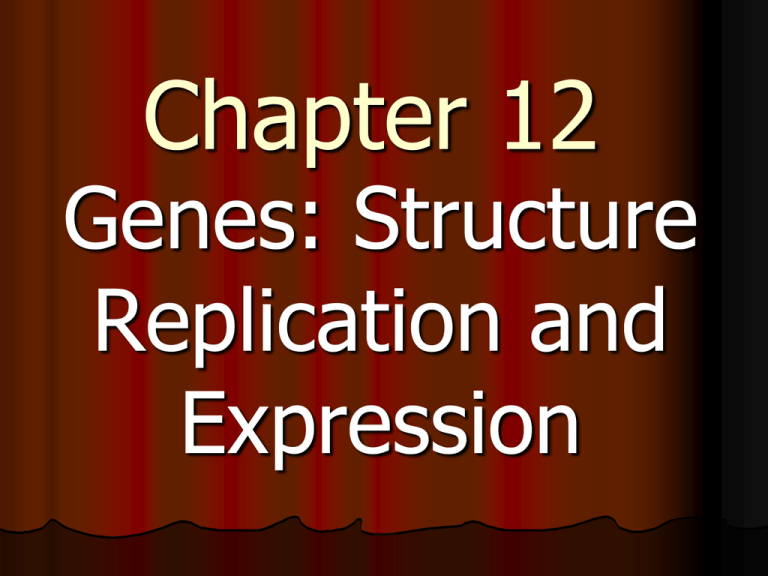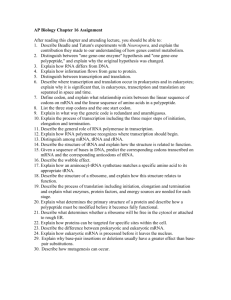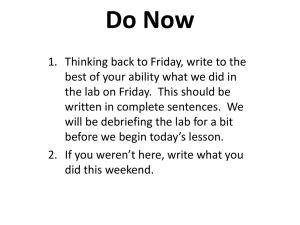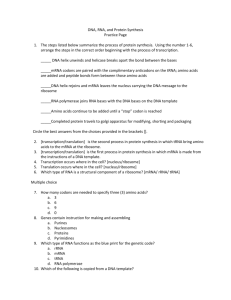Chapter 12: Gene Structure, Replication and
advertisement

Chapter 12 Genes: Structure Replication and Expression Replication: During mitotic division information is duplicated by DNA replication and is passed on to next generation daughter cells has exavcyt replica of the parent DNA Role of DNA in Protein synthesis DNA and protein synthesis involves: Transcription- yields a ribonucleic acid (RNA) copy of specific genes Translation- uses information in messenger RNA (mRNA) to synthesize a polypeptide. Protein synthesis is assisted by RNA (tRNA) and ribosomal RNA (rRNA) Nucleic Acids Nucleic Acid Structure Deoxyribonucleic Acid (DNA) polymer of nucleotides contains the bases adenine, guanine, cytosine and thymine sugar is deoxyribose molecule is usually double stranded DNA is a double-stranded molecule twisted into a helix (think of a spiral staircase). Each spiraling strand, comprised of a sugarphosphate backbone and attached bases, is connected to a complementary strand by noncovalent hydrogen bonding between paired bases. The bases are adenine (A), thymine (T), cytosine (C) and guanine (G). A and T are connected by two hydrogen bonds. G and C are connected by three hydrogen bonds. DNA Structure – Two Complementary Strands base pairing Adenine (purine) and thymine (pyrimidine) pair by 2 hydrogen bonds Guanine (purine) and cytosine (pyrimidine) pair by 3 hydrogen bonds major and minor grooves form when the 2 strands twist around each other Nucleic Acid Structure Ribonucleic Acid (RNA) polymer of nucleotides contains the bases adenine, guanine, cytosine and uracil sugar is ribose most RNA molecules are single stranded RNA Structure three different types which differ from each other in function and in structure messenger RNA (mRNA) ribosomal RNA (rRNA) transfer RNA(tRNA) The Organization of DNA in Cells In most bacteria DNA is a circular, double helix further twisting results in supercoiled DNA in bacteria the DNA is associated with basic proteins help organize the DNA into a coiled chromatin like structure DNA Replication DNA Replication complex process involving numerous proteins which help ensure accuracy the 2 strands separate, each serving as a template for synthesis of a complementary strand synthesis is semi-conservative; each daughter cell obtains one old and one new strand DNA Replication bidirectional from a single origin of replication DNA replication (arrows) occurs in both directions from the origin of replication in the circular DNA found in most bacteria. Rolling Circle Replication some small circular genomes (e.g., viruses and plasmids) replicated by rollingcircle replication Animation illustrating DNA replication by complementary base pairing Genes Gene Structure Gene the basic unit of genetic information also defined as the nucleic acid sequence that codes for a polypeptide, tRNA or rRNA linear sequence of nucleotides codons are found in mRNA and code for single amino acids reading frame organization of codons such that they can be read to give rise to a gene product Importance of Reading Frame Figure 12.16 Genes that Code for Proteins template strand directs RNA synthesis promoter is located at the start of the gene is the recognition/binding site for RNA polymerase functions to orient polymerase leader sequence is transcribed into mRNA but is not translated into amino acids Shine-Delgarno sequence important for initiation of translation Genes that Code for Proteins The Coding Region: begins with the DNA sequence from 3´-TAC-5´ produces codon AUG which codes for Nformylmethionine, a modified amino acid used to initiate protein synthesis in bacteria ( check fig.) coding region ends with a stop codon, immediately followed by the trailer sequence which contains a terminator sequence used to stop transcription Bacterial Gene Structure Genes That Code for tRNA and rRNA • tRNA/rRNA genes have promoter (recognition/binding site for RNA polymerase), leader (is transcribed into mRNA), coding region, spacer and trailer regions (contains a terminator sequence used to stop transcription) during maturation process. Figure 12.19a: leader, spacer, and trailer removed during maturation process rRNA genes have promoter, leader, coding, spacer, and trailer regions Figure 12.19b: spacer and trailer regions may encode tRNA molecules Fig. 12.20 Transcription Transcription RNA is synthesized under the direction of DNA RNA produced has complementary sequence to the template DNA three types of RNA are produced mRNA carries the message for protein synthesis tRNA carries amino acids during protein synthesis rRNA molecules are components of ribosomes Transcription in Bacteria… Definitions to understand protein synthesis: in most bacterial RNA polymerases: Holoenzyme can begin transcription> What is Holoenzyme??* the core enzyme is composed of 5 chains and catalyzes RNA synthesis the sigma factor has no catalytic activity but helps the core enzyme recognize the start of genes *holoenzyme = core enzyme + sigma factor only the holoenzyme can begin transcription Transcription in Bacteria…. • Transcription in Bacteria is catalyzed by a single RNA polymerase. • a reaction similar to that catalyzed by DNA polymerase for DNA syntehsis. • ATP,GTP,CTP and UTP are used to produce a complementary RNA copy of the template DNA sequence http://www.vidoemo.co m/yvideo.php?i=M2FW VDJEcWuRpVGJ0QTg &replicationtranscription-andtranslation= Transcription Process Transcription Initiation Promoter site where RNA polymerase binds to initiate transcription & is not transcribed Transcription Elongation after binding, RNA polymerase unwinds the DNA transcription bubble produced moves with the polymerase as it transcribes mRNA from template strand within the bubble a temporary RNA:DNA hybrid is formed Coupled Transcription and Translation in Prokaryotes Proteins The Genetic Code mRNA sequence is translated into amino acid sequence of polypeptide chain (process = translation). an understanding of the genetic code is necessary before translation is studied. Organization of the Code code degeneracy up to six different codons can code for a single amino acid sense codons the 61 codons that specify amino acids stop (nonsense) codons the three codons used as translation termination signals do not encode amino acids Translation Translation Translation of mRNA into protein: synthesis of polypeptide is directed by sequence of nucleotides in mRNA Ribosome: 70S ribosomes = 30S + 50S subunit site of translation polyribosome (polysome) – complex of mRNA with several ribosomes Translation of mRNA into protein: Three phases: •Initiation •Elongation •Termination •During translation, the mRNA is "read" according to the genetic code which relates the DNA sequence to the amino acid sequence in proteins • Each group of three base pairs in mRNA constitutes a codon, and each codon specifies a particular amino acid (hence, it is a triplet code). •The mRNA sequence is thus used as a template to assemble—in order—the chain of amino acids that form a protein. Transfer RNA (tRNA) and Amino Acid Activation The tRNA molecules are adaptor molecules—they have one end that can read the triplet code in the mRNA through complementary base-pairing, and another end that attaches to a specific amino acid attachment of amino acid to tRNA is catalyzed by aminoacyltRNA synthetases •The translation of mRNA begins with the formation of a complex on the mRNA (Fig. below). • First, three initiation factor proteins (known as IF1, IF2, and IF3) bind to the small subunit of the ribosome. •This preinitiation complex and a methionine-carrying tRNA then bind to the mRNA, near the AUG start codon, forming the initiation complex. The Ribosome •Methionine (Met) is the first amino acid incorporated into any new protein, however, it is not always the first amino acid in translation of protein. •In many proteins, methionine is removed after translation. • The large ribosomal subunit binds to this complex, which causes the release of IFs (initiation factors) once the initiation complex is formed on the mRNA •The large subunit of the ribosome has three sites at which tRNA molecules can bind: • The A (amino acid) site is the location at which the aminoacyl-tRNA anticodon base pairs up with the mRNA codon, ensuring that correct amino acid is added to the growing polypeptide chain. •The P (polypeptide) site is the location at which the amino acid is transferred from its tRNA to the growing polypeptide chain. • Finally, the E (exit) site is the location at which the "empty" tRNA sits before being released back into the cytoplasm to bind another amino acid and repeat the process. •The initiator methionine tRNA is the only aminoacyl-tRNA that can bind in the P site of the ribosome, and the A site is aligned with the second mRNA codon. •The ribosome is thus ready to bind the second aminoacyl-tRNA at the A site, which will be joined to the initiator methionine by the first peptide bond. Elongation of the Polypeptide Chain The next phase in translation is known as the elongation phase . Elongation cycle is the sequential addition of amino acids to growing polypeptide & consists of three phases aminoacyl-tRNA binding transpeptidation reaction Translocation The above process need several Elongation factors ( EF) ………Elongation First, the ribosome moves along the mRNA in the 5'-to-3'direction, which requires the elongation factor G, in a process called translocation …..Elongation Cycle •The tRNA which corresponds to the second codon can then bind to the A site, a step that requires elongation factors (in E. coli, these are called EF-Tu and EF-Ts) and GTP (guanosine triphosphate ) as an energy source for this acitivity. • Upon binding of the tRNA-amino acid complex in the A site, GTP is cleaved to form guanosine diphosphate (GDP), then released along with EF-Tu to be recycled by EF-Ts for the next round. ……….Elongation •In the next step, peptide bonds between the now-adjacent first and second amino acids are formed through a peptidyl transferase activity. •After the peptide bond is formed, the ribosome shifts, or translocates, again, thus causing the tRNA to occupy the E site. •The tRNA is then released to the cytoplasm to pick up another amino acid. •The A site is now empty and ready to receive the tRNA for the next codon. ….Elongation •This process is repeated until all the codons in the mRNA have been read by tRNA molecules & • the amino acids attached to the tRNAs have been linked together in the growing polypeptide chain in the appropriate order. •At this point, translation must be terminated, and the nascent protein must be released from the mRNA and ribosome. Final Phase in Elongation Cycle − Translocation Three simultaneous events: peptidyl-tRNA moves from A site to P site ribosome moves down one codon empty tRNA leaves P site Termination of Translation/protein synthesis: • Three termination codons ( Non-sense or stop codon) that are employed at the end of a protein-coding sequence in mRNA: UAA, UAG, and UGA •No tRNAs recognize these codons. •Instead, release factors (RFs) helps in recognition of stop codons. •Release factors are protein which binds and facilitates release of the mRNA from the ribosome and subsequent dissociation of the ribosome. Several ribosome can align on one mRNA strand and forms several polypeptide chains each with 20 or more amino acids. http://www.vidoemo.com/yvideo.php?i=b mNqSWlEcWuRpNTFoUWs&dnatranslation-animation Prokaryotic and Eukaryotic Translation •The translation process is very similar in prokaryotes and eukaryotes. • Although different elongation, initiation, and termination factors are used, the genetic code is generally identical. • In bacteria, transcription and translation take place simultaneously, and mRNAs are relatively short-lived. •In eukaryotes, mRNAs have highly variable half-lives, • are subject to modifications, and must exit the nucleus to be translated. References http://student.ccbcmd.edu/biotutorials/dna/ fg12.htmlhttp://www.accessexcellence.org /RC/VL/GG/dna_molecule.php http://www.nature.com/scitable/topicpage /Reading-the-Genetic-Code-1042 http://www.nature.com/scitable/topicpage /Translation-DNA-to-mRNA-to-Protein-393






